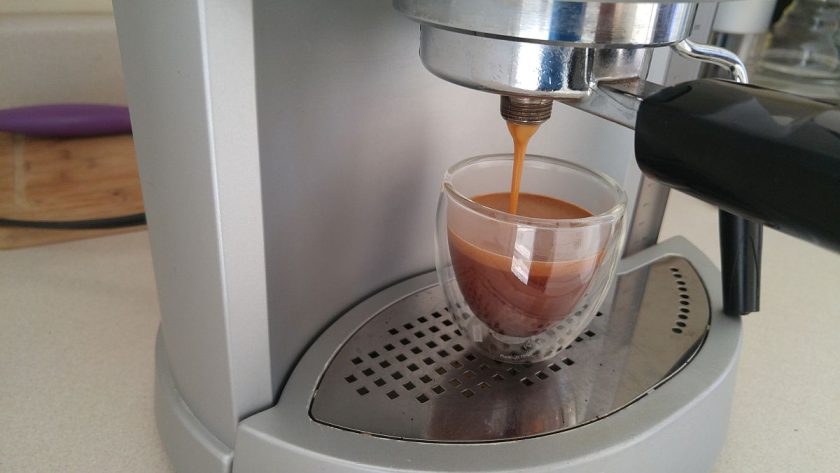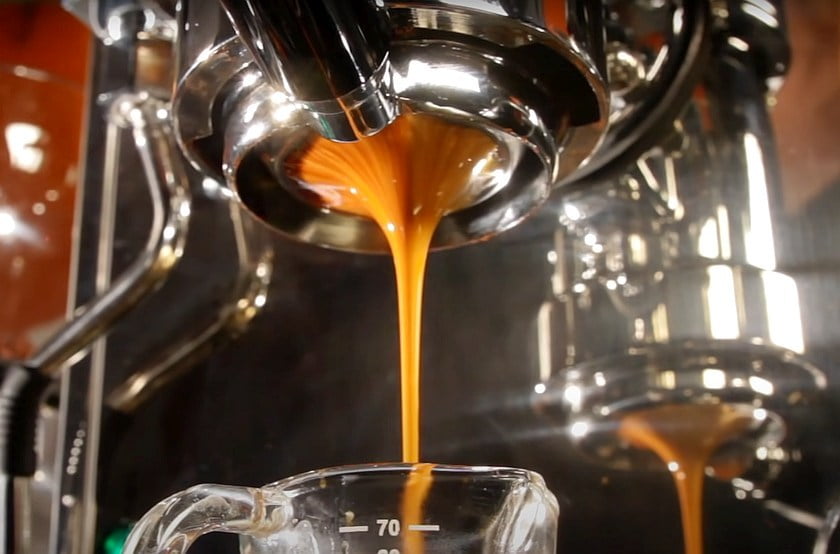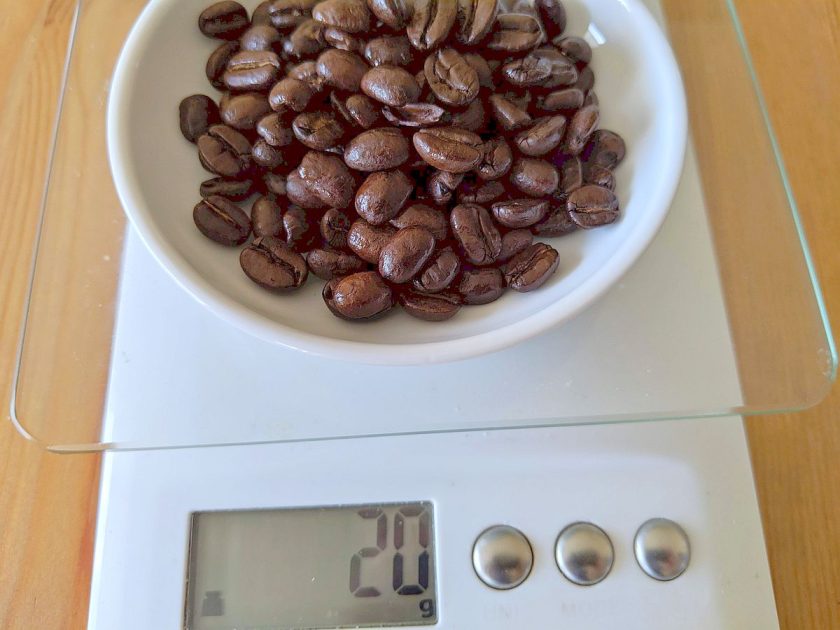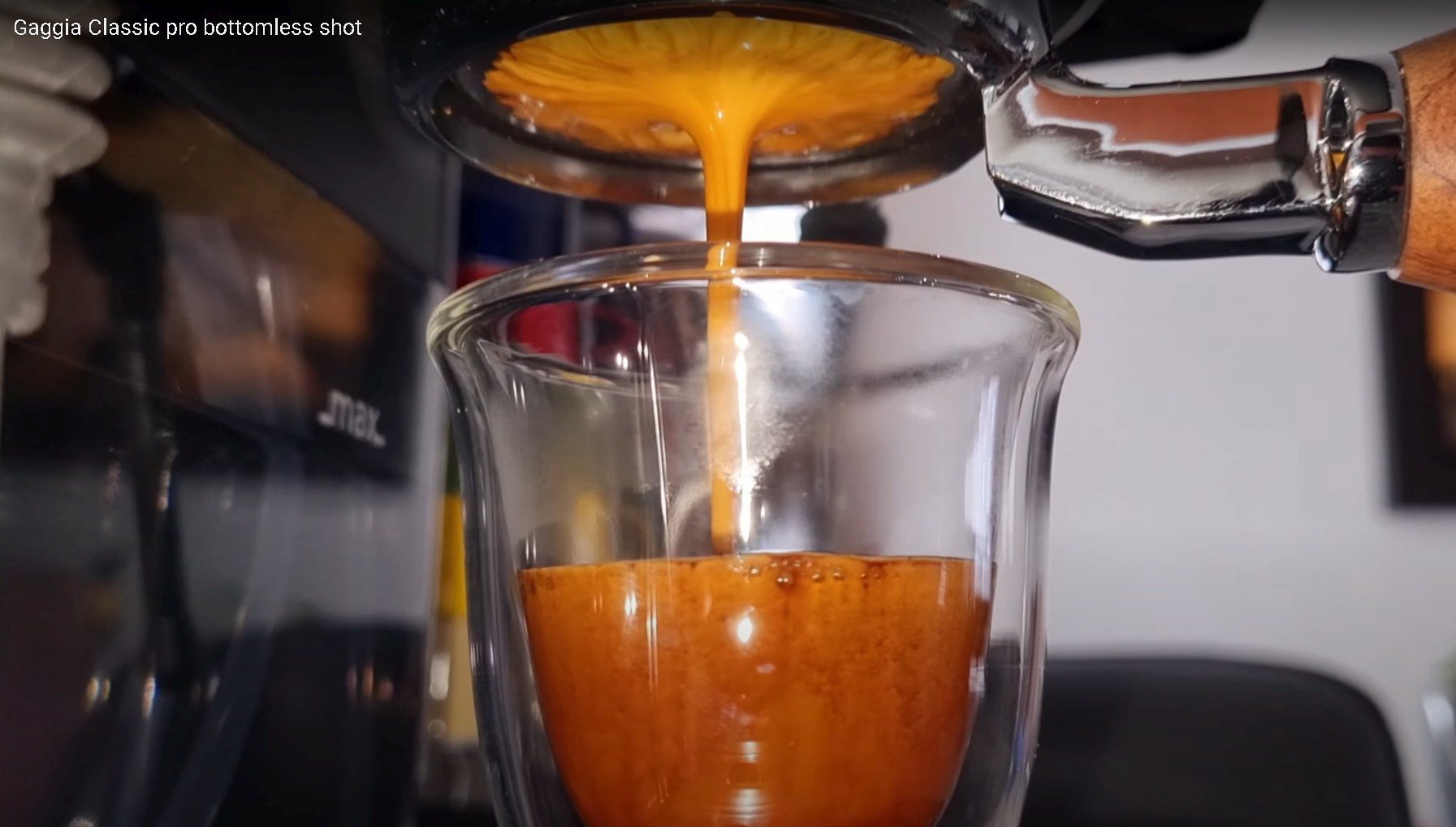Making great espresso is not easy. Chasing the perfect shot, sometimes referred to as the God shot, is a race that requires patience, knowledge, skills and good equipment. Let's not forget great coffee beans.
Yes, the perfect shot of espresso is not impossible. It is within any home barista's reach but you will need a bit of extra work.

This article is not your basic shot pulling tutorial, we have another article for that, if that's what you need. In this article we will focus on the technical aspects that can change your shot. Note that I said change and not improve. This is due to the subjective nature of coffee, but I'll talk about this more in a bit.
I will also show you how to evaluate the appearance, aroma and flavor of an espresso shot. This will help you not only with achieving an excellent shot, but it will also help you perfect all other espresso-based beverages you wish to brew. It will also help you improve your coffee lingo.
- What is The Perfect Espresso Shot?
- What Is the God Shot?
- The Subjective Nature of Coffee
- Objective Factors for Making Great Coffee
- Technical Aspects of Brewing Espresso
- Conclusion
What is The Perfect Espresso Shot?
How Does the Perfect Espresso Look?
A great shot of espresso should have a top of brown foam called crema. This foam is a must because it contains aromatic oils, and it enhances the espresso taste.
There is a debate whether crema contributes positively or not. Famous baristas, whom I respect and follow, stated that you should even remove the crema for a better flavor. I respectfully disagree. Crema tastes amazing.
How does it Taste?
It's hard to describe in words, but the best approximation is that it should taste like coffee smells. Many find it unpleasant, just because it is too intense, or because they down it all at once. You know how great drip coffee smells sometimes. Yet when you drink it, it doesn't resemble at all the smell. Take that drip coffee smell, and think about an enhanced version of it. Think about a flavor twice or three times more intense than that. That's how espresso tastes.
Is espresso bitter? Yes, espresso is bitter. All coffee is bitter, but you get used to it. Once you got used to the bitterness, you start to detect floral notes, caramel, and other tones that the experts talk about. A bad shot, however, can be exceptionally bitter, if you brew it incorrectly. There is a great Quora post, where specialists chime in with an explanation on the espresso bitterness. It's a great read if you are a beginner.
What Is the Aroma of a Perfect Espresso
The perfect shot should be again an experience. The second the shot starts to flow, the room will be filled with intense coffee aroma. Espresso smells like coffee, basically, but more intense. Immediately after brewing, all of the volatile oils are in your cup. The brewing method ensures no aromas are lost during the preparation. With other methods, most of the aroma is lost. Smell your espresso, is part of the ritual. Here is a post where espresso geeks discuss it. If your shot doesn't smell great, it's probably the beans or the brewing parameters.
What Is the God Shot?

The perfect espresso is labeled in barista circles as ‘the God shot' because it's deemed as the cup that has the divine touch. Passionate baristas search for ‘the God shot' in every cup, but they don't always get. The volatile ingredients, the numerous variables involved in during brewing, are many times out of the barista's control.
‘The God shot' attempts to extract the 800 compounds found in ground roasted coffee ina a perfect ratio. Too much of a certain ingredient, or too little of another, the shot is just average. This means controlling to perfection the water temperature, state of the equipment, pressure, timings and storage.
From a technical perspective, when it was coined as a term, the God Shot was a classic double ristretto. The term has evolved, and now it describes an espresso beverage that is perfect. The ristrettos we see now pulled in coffee shops are different from the ones in 2000. But we'll talk about this later in the article.
Don't get caught up in the dictionary, if you think is perfect, that's all that matters. There is no jury to judge your shot.
The Subjective Nature of Coffee
People think that the recipe is the most important for pulling the perfect shot. Let me disappoint you a little. The recipe is not the most important. The two most important factors are espresso knowledge, and good equipment. But let's see what I mean by that.
Coffee is subjective. Unless you are a coffee taster, you will have your preference when it comes to preparing your espresso. Some of us like the normal strength espresso, some like it a lungo, some like it a ristretto.
What is even worse than the shot length, is that people love different extractions. Most people will enjoy that standard espresso extraction, that you find in a coffee shop. However, there is a considerable number of people that like it over-extracted. They love the extra bitterness they get from over extracting a shot.
So how can we objectively label an espresso recipe as “The Perfect”? Or taste a shot and say this is perfect. We can't. What's perfect for me might be underwhelming for you.
This is why the recipe is not the most important. You can start from a recipe, because it's a great way to get good results. But from there you need to tweak it to your own taste. This is why you need knowledge, skills and patience.
You will need to know all brew variables affect your shot, and understand how any variable change will affect your shot. You will also need to spend a lot of time at your coffee station.
Objective Factors for Making Great Coffee
Subjectivity aside, there are a lot of measurable and objective things you can do to make great coffee.
Here is a list, just in case you need a reminder, but we already went through this list on our page about how to make espresso with an espresso machine, and we go in a greater detail on how espresso extraction works in another article.
- Use a good semiautomatic espresso machine.
A super automatic machine won't do it, because you have no control over brewing variables. - For perfect espresso, yo need more expensive equipment
A cheap espresso machine will get you a decent shot, which I'll take any day. But if you want perfection, you need a machine with a PID at a minimum. - Choose a great grinder.
Many people skimp on the grinder, because they want to control their budget. However, for amazing shots, you need great equipment. - Maintain the equipment in a perfect state
The coffee residue that builds up in the brew group, or on the portafilter, is jus nasty. Clean that regularly, and descale your machine on a regular basis. - Use good water
You probably heard this a thousand times. Use good water that is good tasting, and you drink it with pleasure. - Use good quality coffee beans
Not much to explain here… Use great coffee beans, I have another article where I wrote more about espresso coffee beans. - Keep your coffee beans fresh
Buy whole coffee beans for no more than 2 weeks. If you absolutely need to, you can store your beans in the freezer, in an airtight bag. Don't believe what others say about not storing in the freezer, they have never tried it, or did it wrong. - Tweak the grind size, dose and tamp, to create the perfect resistance
If these are not in a perfect balance your shot is not going to be perfect. We talk about this in more detail. - Pre-infusion is important
Make sure you nail the pre-infusion variables perfectly. This is hard to do with a machine that doesn't have the built-in feature. (equipment again…) - Get the timings perfect
When you aim for perfection, one second too long and you get too much bitter flavors. - Tamp uniformly
Tamping uniformly will ensure that coffee grounds will be uniformly extracted. If you tamp a bit off, the puck will have one side taller than the other, and water will flow slower through the tall side, causing uneven extraction. - Avoid channeling
Channeling can happen because of grounds clumping, or uneven distribution in the puck. An espresso distribution tool will fix both of these issues.
Technical Aspects of Brewing Espresso
What Is the Perfect Extraction Time?
A lot of people have different opinions on what constitutes an acceptable extraction time. Many baristas think that 30 seconds is the perfect extraction time, and there is very little tolerance. Other baristas have wider ranges.
I time my espresso shots to pull for about 20 to 25 seconds from the moment the coffee starts to pour in the cup.
I don't need a timer for that, I count to 25 and then stop the shot. However, if you are not confident in your counting pace you should use a timer.
You will see on the Internet a lot of espresso guides recommending 30 seconds, but they don't say if that is from the moment you flick the start button on, or from the moment you see the first coffee drop on the portafilter. Assume they mean from the moment you turn the switch on. Otherwise, 30 seconds is a bitt longer than the ideal.
Espresso Shot Timer
What Is the Perfect Brew Ratio?
When pulling an espresso, time is only one of the variables. The volume of coffee extracted is also important. The ratio between the amount of coffee grounds used and the brewed coffee is called brew ratio.
The brew ratio is a personal choice. It can make, or break your espresso. Let's dive a little deeper into this subject because this is very important.
The traditional espresso is brewed with 7-8 grams of dry coffee to obtain a 1 fluid ounce, (30 milliliters), of coffee for a normale. This is a 1:4 ratio. Modern espresso uses a 1:2 brew ratio, which is a very short shot. In fact this is the traditional espresso ristretto brew ratio.
Traditional Espresso Brew Ratio
For a traditional espresso solo, normale, we use 7-9 grams of dry coffee, and we get a shot around 1 ounce. The brew ratio for this beverage is 1:3 to 1:4. For a doppio normale the beverage volume is 2 ounces, (50 to 60 ml).
A traditional solo ristretto, is pulled with 7-9 grams of dry coffee, to obtain a 15 – 20 milliliters of coffee. A doppio ristretto is 30 – 40 milliliters. The brew ratio for the classic ristretto is 1:2.
A traditional solo lungo is a 4 ounce beverage prepared using 7-9 grams of dry coffee. A lungo can vary in length/strength. We can pull longer or shorter shots than the 4 ounces. The range is anything between 3 to 5 ounces. This means the brew ratio for a classic lungo is 1:6 to 1:12.
I personally like the traditional shot length. Italian baristas and restaurateurs will also favor the traditional espresso recipe. However, to each their own, so there will be no judgement here.
Espresso Brew Ratio Table
Let's look at the brew ratio in a structured way. Note that these numbers are just guides. Each coffee shop chooses their way of preparing espresso, and each home barista perfects their own recipe.
| Ristretto | Normale | Lungo | |
| Traditional | 1:2 | 1:4 | 1:8 |
| Modern | 1:1 | 1:2 | 1:3 |
A final note on measuring your output. I have seen baristas pulling shots on a kitchen scale, but this is not absolutely necessary. The scale is useful in order to avoid volume confusions created by crema. Crema has a larger volume in the cup, having a lot of gas in its composition. As the gas is released, crema dissipates and we are left with the real volume of the coffee.
This is just to explain that if you think you can approximate the total volume of the coffee subtracting the volume of crema, you don't need a scale. But if you think you can't the use it.
What is the Perfect Temperature for Brewing Espresso?
The perfect espresso brewing temperature is a range. It's anywhere between 190°F and 205°F. Using this range blindly is safe for an average espresso, but if you aim for the God shot, you have to dial in your temperature in the same way you dial in the grind size.
Lighter roasts might benefit from a higher brewing temperature, whereas darker roast, are easier to extract so lower brewing temps are more appropriate.
What Is the Perfect Yield for Espresso?
Yield is the amount of coffee we have in the cup after brewing. Yield is different for the various espresso lengths. A ristretto has the lowest yield, and a lungo has the highest yield. Yield is typically predetermined by the recipe. Changing the yield will affect the strength and the extraction of the shot. The higher the yield the higher the extraction, but the lower the coffee strength.
In some coffee shops, you only see one grinder for the espresso. This means they can only prepare one of the three espresso lengths. Yield highly depends on grind size. The coarser the coffee the higher the yield. The finer the grind, the lower the yield.
These assumes the extraction time is invariable.
Espresso Extraction Rate
Extraction refers to the the amount of soluble solids we dissolve into our cup of coffee. It is measured relatively to the coffee used. It's a percentage. Coffee contains about 30% soluble matter, so this is the maximum extraction possible. The best extraction rate is somewhere around 18 to 21% of the dry coffee.
Extraction can be measured by drying up the spent coffee puck, and weigh it. The weight difference is the extraction.
A little unintuitive fact here, by increasing the extraction we decrease the strength. This is because extraction rate decreases during pulling a shot. It is very fast at the beginning, then it slows down a lot by half time.
Espresso Strength
Espresso strength is one of the variables that you control. You brew it how you like it.
If you want a stronger cup, just stop the brewing faster. If you want a longer coffee, pull the shot a few seconds longer.
But know that longer extraction means over-extraction. So you will get a weaker coffee, but it will be over extracted.
What Is the Perfect Espresso Dose?

Here is where things are getting muddy. The dose varies so much, and so many coffee shops are doing their own thing, that a definitive answer is hard to give.
Many cafés are pulling ristrettos, and not normale. This means that for the same dose they get less coffee in the cup. A well extracted ristretto is sweeter than a normale, but more concentrated.
What is the Perfect Grind Size for a Great Espresso Shot?
The grind size is one of the variables that the barista has to tweak in order to get a 30 grams shot pulled for 25 seconds. If the grind is to coarse the shot will pull too fast, and we risk an under extraction. If the grind is too fine the shot will pull too slow, and we risk over extraction.
Conclusion
I totally get it if you got bored by this article, but if you made it trough the entire article and reached the conclusion, you are on your way to making great espresso. If you haven't read it yet, we have an article where we talk about espresso extraction, and we touch on all of the brewing variables, and how they interact. It's a great next step to better understanding espresso. Oh, since we are still recommending you stuff to read, take a look at our guide on how to make an espresso with an espresso machine.
